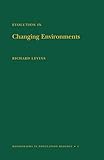Evolution in changing environments: some theoretical explorations
Series: Monographs in population biology ; 2Publication details: Princeton: Princeton University Press, [c1968]Description: 120 pISBN: 9780691080628LOC classification: QL752 .L4| Item type | Current library | Shelving location | Call number | Status | Date due | Barcode | Item holds |
|---|---|---|---|---|---|---|---|
 Book
Book
|
ICTS | Rack No 14 | QL752 .L4 (Browse shelf (Opens below)) | Available | 02784 |
1. On theories and Models
2. Strategies of Adaptation
3. The Theory of the Niche
4. The Species in Space
5. The Genetic System
6. From Micro- to Macro- Evolution
Professor Levins, one of the leading explorers in the field of integrated population biology, considers the mutual interpenetration and joint evolution of organism and environment, occurring on several levels at once. Physiological and behavioral adaptations to short-term fluctuations of the environment condition the responses of populations to long-term changes and geographic gradients. These in turn affect the way species divide the environments among themselves in communities, and, therefore, the numbers of species which can coexist. Environment is treated here abstractly as pattern: patchiness, variability, range, etc. Populations are studied in their patterns: local heterogeneity, geographic variability, faunistic diversity, etc.---provided by publisher


There are no comments on this title.